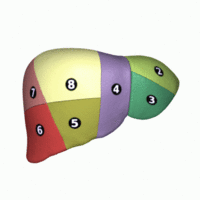| Liver segment | |
|---|---|
 Shape of human liver in animation. Eight segments by Couinaud labelled. Shape of human liver in animation. Eight segments by Couinaud labelled. | |
| Details | |
| Part of | Liver |
| Anatomical terminology[edit on Wikidata] | |
A liver segment is one of eight segments of the liver as described in the widely used Couinaud classification (named after Claude Couinaud) in the anatomy of the liver. This system divides the lobes of the liver into eight segments based on a transverse plane through the bifurcation of the main portal vein, arranged in a clockwise manner starting from the caudate lobe.
Couinaud segments

There are four lobes of the liver. The Couinaud classification of liver anatomy then further divides the liver into eight functionally independent segments. Each segment has its own vascular inflow, outflow and biliary drainage. In the centre of each segment there is a branch of the portal vein, hepatic artery and bile duct. In the periphery of each segment there is vascular outflow through the hepatic veins. The division of the liver into independent units means that segments can be resected without damaging the remaining segments. To preserve the viability of the liver following surgery, resections follow the vessels defining the peripheries of each segment. This means that resection lines parallel the hepatic veins, leaving the portal veins, bile ducts, and hepatic arteries intact.
The classification system uses the vascular supply in the liver to separate the functional segments (numbered I to VIII)
Caudate lobe
Segment I is the caudate lobe and is situated posteriorly. It may receive its supply from both the right and the left branches of portal vein. It contains one or more hepatic veins which drain directly into the inferior vena cava (IVC).
The caudate lobe is a separate structure which receives blood flow from both the right- and left-sided vascular branches.
The Caudate lobe includes: (1) the Spiegel lobe; (2) the paracaval portion; and (3) the caudate process portion. The Spiegel lobe has its portal venous and biliary branches ramified mainly from the left-side tract. The Paracaval portion has the portal venous branches ramified mainly from the left portal vein, while the biliary branches of this portion drained into the right and left biliary tracts at almost equal frequencies. The portal venous branches & Biliary branches of the caudate process portion has it ramified from the right-side tract.
Left lobe
Segments II and III lie medial to the falciform ligament with II superior to the portal venous supply and III inferior. Segment IV lies lateral to the falciform ligament and is subdivided into IVa (superior) and IVb (inferior).
Right lobe
Segments V to VIII make up the right part of the liver:
- Segment V is the most medial and inferior
- Segment VI is located more posteriorly
- Segment VII is located above segment VI
- Segment VIII sits above segment V in the superior-medial position
Quadrate lobe
The fissure for the round ligament of the liver (ligamentum teres) separates the medial and lateral parts of segment IV. The inferior medial segment (IVb) is also called the quadrate lobe.
Society
The clockwise numbering of liver segments in Couinaud's classification is said to have been inspired by the numbering of arrondissements (administrative districts) of Paris.
References
- ^ "Couinaud classification | Radiology Reference Article". Radiopaedia.org. Retrieved 2015-06-26.
- Kapoor, Vinay Kumar (14 September 2017). "Liver Anatomy: Overview, Gross Anatomy, Microscopic Anatomy". Medscape.
- ^ "The Radiology Assistant : Anatomy of the liver segments". Radiologyassistant.nl. 2006-05-07. Retrieved 2015-06-26.
- "Hepatic segments (Couinaud classification) / Radiological classifications commonly used on medical imaging / Radiology / Channels / e-Cases /". IMAIOS.com. Retrieved 2015-06-26.
- "Three-dimensional Anatomy of the Couinaud Liver Segments". Retrieved 2009-02-17.
- Strunk, H.; Stuckmann, G.; Textor, J.; Willinek, W. (2003). "Limitations and pitfalls of Couinaud's segmentation of the liver in transaxial Imaging". European Radiology. 13 (11): 2472–82. doi:10.1007/s00330-003-1885-9. PMID 12728331.
- Sibulesky, Lena (March 2013). "Normal liver anatomy". Clinical Liver Disease. 2 (S1): S1–S3. doi:10.1002/cld.124. PMC 6448666.
- Germain, T.; Favelier, S.; Cercueil, J.-P.; Denys, A.; Krausé, D.; Guiu, B. (November 2014). "Liver segmentation: Practical tips". Diagnostic and Interventional Imaging. 95 (11): 1003–1016. doi:10.1016/j.diii.2013.11.004. PMID 24388431.
- Majno, Pietro; Mentha, Gilles; Toso, Christian; Morel, Philippe; Peitgen, Heinz O.; Fasel, Jean H. D. (2014-03-01). "Anatomy of the liver: An outline with three levels of complexity – A further step towards tailored territorial liver resections". Journal of Hepatology. 60 (3): 654–662. doi:10.1016/j.jhep.2013.10.026. ISSN 0168-8278.
| Anatomy of the liver, pancreas and biliary tree | |||||
|---|---|---|---|---|---|
| Liver | |||||
| Biliary tract |
| ||||
| Pancreas |
| ||||